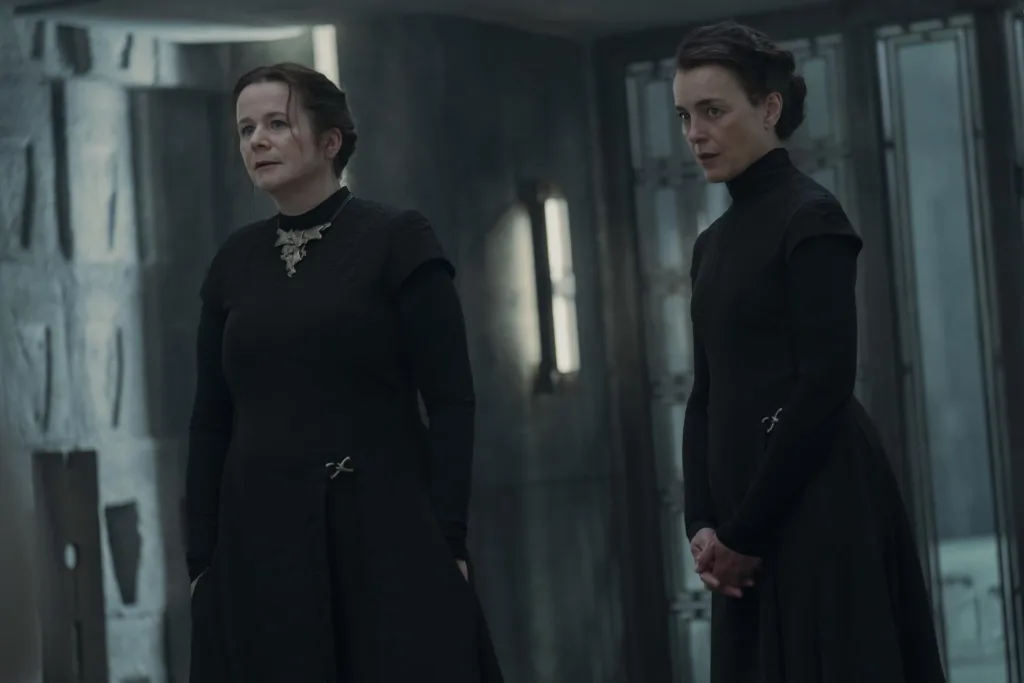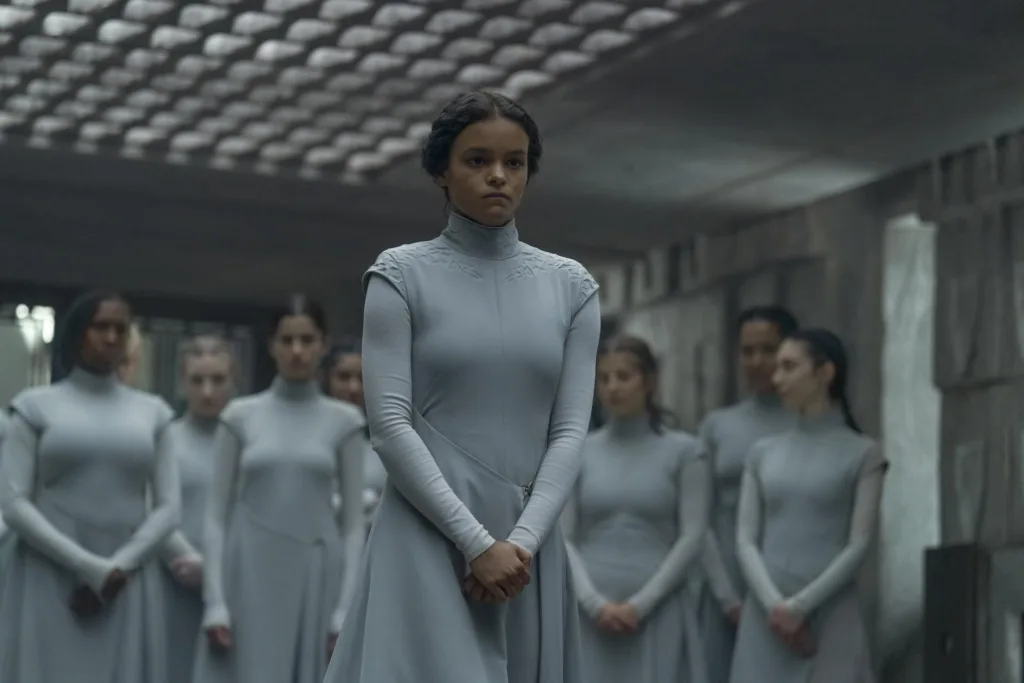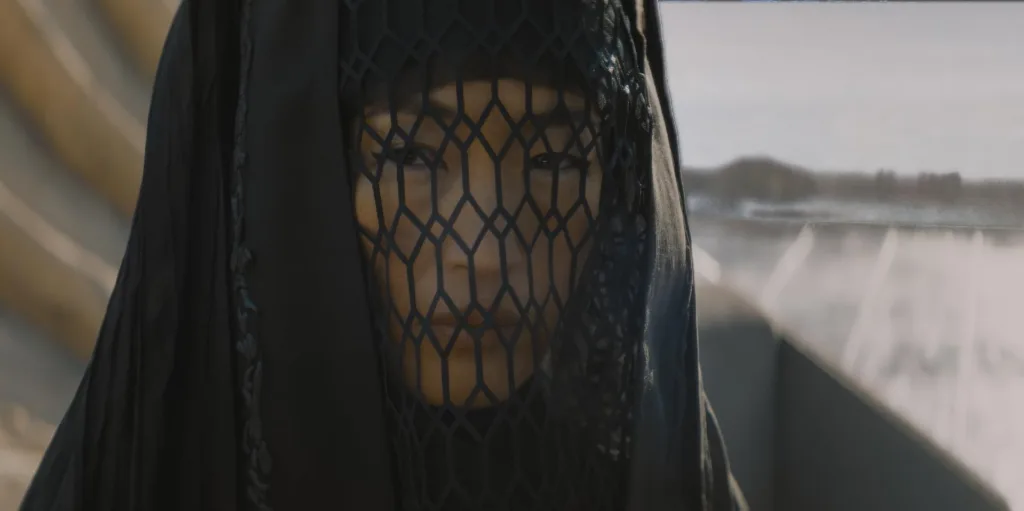“Dune: Prophecy,” HBO’s newest science fiction show, emerges as a daring investigation of the vast Dune world that traces the mysterious Bene Gesserit sisterhood’s early beginnings. Based on Brian Herbert and Kevin J. Anderson’s prequel book “Sisterhood of Dune,” the series goes into uncharted narrative territory by setting the story 10,000 years before the events of Denis Villeneuve’s movies.
The series adds to the Dune mythology in a planned way, giving fans a close look at how the sisterhood came to be during a rough time in human-galactic history. “Prophecy,” set in the aftermath of the Butlerian Jihad, humanity’s war against thinking machines, gives important background to the social and technological limitations that make up the Dune world. This narrative approach can help audiences understand the political and religious underpinnings of the events that audiences know from the original books and films.
The series focuses on Bene Gesserit’s early years and hopes to shed light on one of the most interesting groups in science fiction. The show’s idea is based on the sisterhood’s early struggles, political maneuvering, and the start of their famous breeding program—a complicated plan to create a superhuman leader who would completely change human society.
The series uses known Dune lore for inspiration but also creates its own narrative space. The creators of the show set the story in a time full of possibilities—a time of rebuilding, political intrigue, and new power structures that will shape the known world in the long run.
Weaving Timelines: The Intricate Narrative of Dune: Prophecy
What makes “Dune: Prophecy” special is its complicated narrative structure, which defies conventional linear storytelling. The Harkonnen sisters, Valya and Tula, establish the Bene Gesserit sisterhood, and the series is primarily set against the backdrop of humanity’s recovery from the terrible Butlerian Jihad.
The narrative is strong because it uses flashbacks to show how the sisters’ early lives shaped them. These changes in time aren’t just for show; they help us understand why Valya and Tula are doing what they’re doing. Jessica Barden’s portrayal of Valya shows her early ambition and scrappy determination to raise her family’s standing. At the same time, Emily Watson’s portrayal of the same character is more refined and politically astute.
The series weaves several interesting subplots parallel to the sisters’ trip to broaden the narrative. The sisterhood’s schemes are interesting, but the political games played by House Corrino, with Mark Strong’s Emperor Javicco as an easy-to-control leader, are even more interesting. Characters like the young Princess Ynez and the mysterious Desmond Hart add to the mystery and show how power shifts in the Imperium as it grows.
The show’s geographical diversity—it shifts between the austere Wallach IX and the sparkling Salusa Secundus—reflects the complexity of its narrative. Each setting becomes more than just a background; it becomes an active character in the storytelling, expressing the characters’ inner conflicts and the larger social and political situation.
“Dune: Prophecy” tells a complex story that goes beyond a simple origin story by weaving together human stories with larger historical movements. It also offers a nuanced look at power, ambition, and institutional formation.
The Architects of Destiny: Character Dynamics in Dune: Prophecy
The captivating performances of Emily Watson and Olivia Williams as the Harkonnen sisters make “Dune: Prophecy” such a captivating character study. The two-timeline method lets us get to know Valya and Tula’s characters more deeply, showing how their goals and morals change over time.
The character of Valya, played by Emily Watson, emerges as a masterwork of ambition and cunning. She is shown to be the driving force behind the Bene Gesserit’s early schemes, and her cruel drive changes the sisterhood. Jessica Barden, who plays her younger sister, gives important background information by showing how Valya’s rough-and-tumble personality came to be. Watson gives the part a magnetic intensity, especially when she’s with Travis Fimmel’s Desmond Hart. Their scenes together are full of silent tension and political maneuvering.
Olivia Williams’s Tula is the opposite of Valya’s drive. Her character arc may be more complex, showing a softer side that gets more complicated as the series progresses. Williams shines in her scenes with Chloe Lea’s young acolyte Lila. She shows a maternal depth that differs greatly from the political drama around her. The most interesting connection in the series is the one between Valya and Tula, who are sisters. Their relationship is a delicate balance of support and tension.
The supporting cast greatly improves the narrative. Mark Strong’s Emperor Javicco Corrino stands out because he is a king who is both haunted and manipulated and represents how unstable politics were at the time. Sarah-Sofie Boussnina gives Princess Ynez a lot of depth I didn’t expect. She turns a character that could have been one-dimensional into a complex young leader who deals with tricky political situations.
The most mysterious character in the series is Desmond Hart, played by Travis Fimmel. Hart is not a simple stereotype; Fimmel gives him zeal and complexity, making watchers always wonder about his real goals.
The ensemble does a great job of making a world where every character feels part of the larger narrative. Each performance adds to the complex tapestry of the Dune world, from Jodhi May’s distrustful empress to the young acolytes training in the sisterhood.
Forging a Galactic Mythology: World-Building in Dune: Prophecy
“Dune: Prophecy” emerges as a masterful expansion of the Dune world, providing a rare in-depth look at the early interstellar civilization’s socio political landscape. Set in the crucial time right after the Butlerian Jihad, the series gives a detailed look at how the terrible war against thinking machines completely changed society and how institutions work.
The show’s world-building is especially impressive in its handling of the Imperium’s new government system. This era shows a more fluid power dynamic than the rigid hierarchy in later Dune narratives. The Bene Gesserit sisterhood is positioned as a transformative force rather than the established power we know from later narratives, and the series carefully illustrates the emerging roles of important organizations.
The use of planetary images in narrative. The sisterhood’s homeworld reflects their austere, orderly nature, and Wallach IX emerges as more than just a background. It becomes a character all its own. In contrast to the post-war trauma that still lingers in people’s minds, Salusa Secundus is portrayed as a shining hub of imperial power.
The aftermath of the Butlerian Jihad provides an interesting narrative structure. The series gives us deep views into how people relate to technology by showing how society reacts to the end of technology. The sisterhood’s breeding program, created as a plan to deal with this historical pain, becomes a powerful metaphor for how people can bounce back from bad situations and find new ways to do things.
Cultural differences are carefully considered. From House Corrino’s political maneuverings to the specialized training within the Bene Gesserit, the series delves into complex social structures, showing a society that is both fragile and ambitious. Adding new groups, like rebel groups and new houses in the Landsraad, shows that society is rich and complicated.
The series’ commitment to natural world-building sets “Prophecy” apart. It weaves historical context into character motivations and narrative development without feeling like an exposition-heavy prequel.
Sculpting a Visual Mythology: The Aesthetic Landscape of Dune: Prophecy
What makes “Dune: Prophecy” stand out is its carefully made visual language, which goes beyond what you’d expect from a TV show. Under Tom Meyer’s art direction, the series creates a visual narrative just as complicated and multilayered as its storytelling, consciously moving away from the golden-hued desert aesthetics of the Villeneuve films while maintaining a strong visual continuity.
A narrative device, the production design serves as more than just a background. For example, the library of the sisterhood develops into a character in and of itself. It is austere and geometric and has dark corners that suggest hidden information. Salusa Secundus is painted in cool, metallic tones that evoke the clinical accuracy of imperial power. At the same time, Wallach IX uses a stark, monastic palette that represents the disciplined nature of the Bene Gesserit.
The costume design by Bojana Nikitovic emerges as a surprising component. The Bene Gesserit veils are more than just clothes; they are sophisticated visual metaphors. They are layers of fabric that hide and show simultaneously, representing the sisterhood’s complicated relationship with power and secrecy. Each costume is a complex social order text, with small changes in fabric, cut, and drape showing complex social details.
The color scheme is intentionally simple. Cool grays, deep blacks, and soft earth tones make up most of it, making it feel both old and new. Shadowed interiors and stark contrasts highlight the characters’ internal struggles, making lighting a narrative tool.
The series doesn’t have the huge sandworm scenes like the films, but the special effects are well done. To avoid spectacle and emphasize narrative coherence, the portrayal of thinking machines and technological leftovers from the Butlerian Jihad feels natural and integrated.
The most amazing thing about the production is that it keeps a cinematic feel that pushes the usual boundaries between TV and movies. Each frame is assembled with an artistic accuracy that makes you want to think about it for a long time.
Threads of Destiny: Thematic Complexity in Dune: Prophecy
Incorporating a narrative beyond typical science fiction storytelling, “Dune: Prophecy” is a profound meditation on power’s complex manifestations. The series mostly concerns the tricky area where personal goals and group survival meet. The Bene Gesserit sisterhood is used as a complicated example to look at how power works in institutions.
The relationship between Valya and Tula Harkonnen shows how the main ideas of the series play out in small ways. Their sisterly bond is strong and tense at the same time, which raises bigger questions about the difference between family loyalty and societal commitment. This relationship is more complex than family rivalry; it shows how different people’s wants and needs interact with bigger historical forces.
Prophecy and set fate emerge as important narrative devices. In this series, prophecies are not seen as mystical truths but as strategic tools for political and social manipulation. The Mother Superior’s warning about a coming “reckoning” becomes a pivotal point in the narrative, driving character motivations while maintaining an air of existential uncertainty.
The deliberate narrative fragmentation used in the storytelling method makes it unique. Nonlinear storytelling is not just a style choice but a statement about the theme. By showing different points of view from different times, the series argues that understanding history is inherently subjective and multifaceted. Flashbacks are not used to explain things; instead, they explore characters’ minds deeply, showing what drives them through carefully built layers of time.
Moral ambiguity turns out to be the most interesting intellectual topic in the series. Each character is a complicated negotiation of survival, ambition, and institutional responsibility; no character is presented as simply heroic or villainous. In the case of the Bene Gesserit, their breeding scheme is both a smart way to stay alive and a morally dubious business.
With a mentally challenging and emotionally compelling narrative, the series consistently goes against what viewers expect. Power is not presented as a black-or-white idea but rather as a fluid, multidimensional experience shaped by one’s past, the limitations of institutions, and the need to survive as a group.
Bridging Universes: Dune: Prophecy’s Narrative Accessibility
“Dune: Prophecy” does the difficult thing of telling a narrative that will please both longtime Dune fans and people who have never been into this complicated world. Deep mythological exploration is balanced with character-driven storytelling that doesn’t assume much background information in this series.
For true fans, the show is a great trove of historical information. Subtle allusions to significant events in Dune’s long history, especially the aftermath of the Butlerian Jihad, give us a lot of information about the beginning of the world. The search for the Bene Gesserit’s roots feels like digging up the past, showing the institutional DNA that will shape future narratives.
Newcomers will find the series surprisingly easy to get into. “Prophecy” prioritizes character development and political intrigue over detailed explanations, unlike many prequel tales that fall apart under the weight of their mythology. With its compelling character arcs and high-stakes interpersonal conflicts, the show shares narrative DNA with complicated political dramas like “Game of Thrones” and gives viewers easy entry points.
The series is different from other epic tales because it focuses on how institutions are formed. “Dune: Prophecy” is a more complex look at how transformative groups grow from historical trauma. “House of the Dragon” is about the succession of a king, and “The Wheel of Time” is about the hierarchy of magic.
Many factors affect engagement. Strong performances and high production values keep viewers emotionally invested, while the nonlinear storytelling keeps them thinking. The narrative gains momentum continuously from unexpected plot twists and the slow reveal of Bene Gesserit’s long-term plans.
Most importantly, the show values its viewers’ brains. Without complicated explanations or boring world-building, it presupposes viewer interest and adds richness to the narrative.
The Review
Dune: Prophecy
Beyond conventional science fiction storytelling, "Dune: Prophecy" emerges as a daring and intellectually rigorous reimagining of the Dune world. By focusing on how the Bene Gesserit sisterhood came to be, the series gives a complex look at power, how institutions are formed, and how people change over time that goes far beyond just adding to the franchise. The show's strengths are the Harkonnen sisters' complex character growth and commitment to narrative depth. While the production design creates a visual language that is both strange and deeply human, Emily Watson and Olivia Williams give performances that ground the series in emotional reality. The series rewards patience with a rich, layered storytelling approach that deepens our understanding of the Dune mythology, even though it requires active viewer engagement and may be difficult for those wanting more straightforward narrative experiences. It's great that the show can connect die-hard franchise fans with people who have never seen any of the movies before. It makes the narrative feel both familiar and new. Its commitment to institutional power, survival tactics, and human potential elevates it above typical science fiction.
PROS
- Exceptional performances, especially by Emily Watson and Olivia Williams
- Deep world-building and rich historical context
- Innovative narrative structure with nonlinear storytelling
- Visually stunning production design
- Intellectually sophisticated exploration of power and institutional formation
- Strong character development
- Accessible to both Dune fans and newcomers
- Unique take on the Bene Gesserit origin story
CONS
- Complex narrative might be challenging for casual viewers
- Requires significant viewer investment and attention
- Slower pacing compared to more action-oriented science fiction series
- Limited action sequences
- Potentially overwhelming for viewers unfamiliar with Dune lore





















































